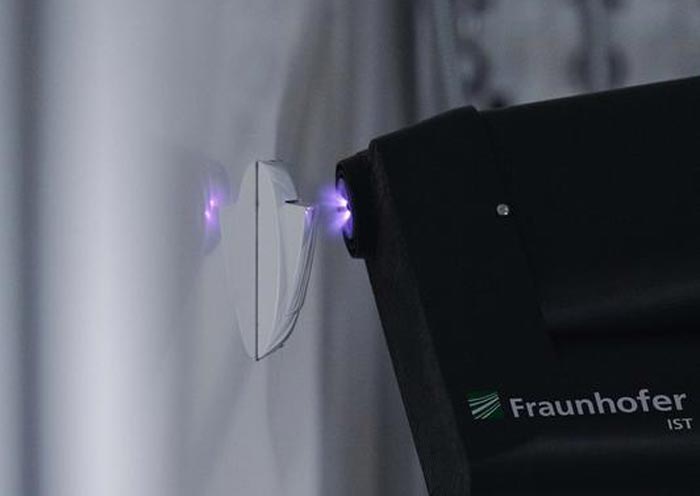Modular plasma system ensures hygienic surfaces

Modular plasma source for cleaning and disinfection of surfaces.
Paul Kurze / © Fraunhofer IST
A reduced risk of infection and, as a consequence, a decrease in new infections are goals that have become even more important during the Corona pandemic. One important factor thereby is the cleaning and disinfection of potentially contaminated surfaces. In the “MobDi – Mobile Disinfection” project, 12 Fraunhofer institutes collaborated on the development of new technical solutions for efficient and target-oriented robot-based disinfection. The Fraunhofer Institute for Surface Engineering and Thin Films IST developed a modular plasma system which can be integrated into these types of mobile disinfection robots.
Particularly in public buildings or modes of transport, the cleaning and disinfection of surfaces plays a major role, especially against the backdrop of the current infection situation. The ideal solution would be for frequently accessed rooms to be thoroughly cleaned on a regular basis – several times a day, preferably – which, however, is only possible to a limited extent due to the enormous (personnel) outlay involved. Mobile service robots could provide a remedy here and, simultaneously, also help to reduce the risk of infection.
The challenge for the participating researchers lay in finding suitable approaches that would clean the surfaces efficiently without damaging them in the process. For this purpose, the project encompassed the testing and evaluation of various disinfection methods and technologies that can be applied in accordance with the material, geometry and degree of soiling of the areas to be cleaned.
Using plasma to combat viruses and bacteria
If a gas is supplied with sufficient energy, a plasma can be generated. The plasma consists of electrons, ionized and excited particles as well as UV light; these lead, amongst other things, to chemical and biological reactions which are very suitable for cleaning and disinfection purposes. The Fraunhofer IST focused its attention primarily on the selection and integration of a suitable plasma source. Due to the application and integrability, following extensive preliminary investigations a piezo-jet system was further developed in which the surface material is treated in a gentle manner by means of a “cold plasma”.
Initially problematic was the formation of ozone, which occurs when the plasma is ignited. “In order to prevent the ozone from escaping into the environment, we identified the optimum extraction conditions by means of simulations and then designed a corresponding concept,” explained Prof. Dr. Michael Thomas, Head of Department at the Fraunhofer IST. “The utilization of absorbents furthermore ensures the complete reduction of ozone from the extraction, as a result of which the plasma source can be used without hesitation for cleaning and disinfection in daily operation.” The final step in the work at the Fraunhofer IST was the implementation of the obtained results in an appropriate design and the construction of a complete plasma system which can be integrated directly into the cleaning robot.
Prof. Thomas is very pleased with the successful development. “It is wonderful that we can provide a small contribution towards making the cleaning and disinfection of surfaces safer and more efficient – particularly in the current situation,” he explained. “The result of our research is a completely self-sufficient plasma system with an integrated generator as well as an extraction system with an ozone-filter unit which, thanks to its modular design, can be easily incorporated into various cleaning robots.” The cleaning and disinfection of surfaces, particularly in indoor areas, constitutes an important field of research at the Fraunhofer IST. Markets here include the interiors of vehicles and means of transport as well as rooms in sensitive infrastructures such as hospitals or care facilities.
The project
Full title of the project: Mobile Disinfection – MobDi
Duration: 01.10.2020 to 30.11.2021
Website: www.mobdi-projekt.de/en
Funding: The project is part of the “Fraunhofer vs. Corona” action program, which supports numerous other initiatives for combating the pandemic.
Weitere Informationen:
https://www.ist.fraunhofer.de/en/press-media/2022/modular-plasma-system-ensures-…
Media Contact
All latest news from the category: Architecture and Construction
Newest articles

Innovative 3D printed scaffolds offer new hope for bone healing
Researchers at the Institute for Bioengineering of Catalonia have developed novel 3D printed PLA-CaP scaffolds that promote blood vessel formation, ensuring better healing and regeneration of bone tissue. Bone is…

The surprising role of gut infection in Alzheimer’s disease
ASU- and Banner Alzheimer’s Institute-led study implicates link between a common virus and the disease, which travels from the gut to the brain and may be a target for antiviral…

Molecular gardening: New enzymes discovered for protein modification pruning
How deubiquitinases USP53 and USP54 cleave long polyubiquitin chains and how the former is linked to liver disease in children. Deubiquitinases (DUBs) are enzymes used by cells to trim protein…



